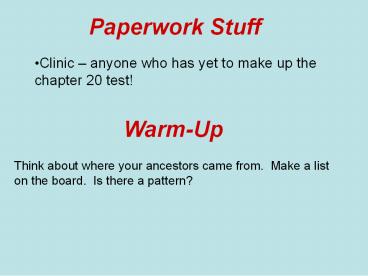Paperwork Stuff - PowerPoint PPT Presentation
1 / 18
Title:
Paperwork Stuff
Description:
Paperwork Stuff Clinic anyone who has yet to make up the chapter 20 test! Warm-Up Think about where your ancestors came from. Make a list on the board. – PowerPoint PPT presentation
Number of Views:132
Avg rating:3.0/5.0
Title: Paperwork Stuff
1
Paperwork Stuff
- Clinic anyone who has yet to make up the
chapter 20 test!
Warm-Up
Think about where your ancestors came from. Make
a list on the board. Is there a pattern?
2
Where did your ancestors come from?
Europe North America South America Asia Africa Australia
Do you see a pattern? ? Why do you think this
is?
3
(No Transcript)
4
Section 1New Immigrants in a Promised Land
CHAPTER 21 A NEW URBAN CULTURE
5
Emigrate / Emigrant
A person who leaves a country in order to settle
in a another one.
Immigrate / Immigrant
A person who enters another country in order to
settle there.
6
Why did Immigrants come to the U.S.?
Push Factors (Reasons why people left there
homes)
Lack of land Jobs lost to machines Political
Persecution Religious Persecution Revolution /
War Poverty / Hard times
Europe
Asia
____________________________ ___________________
______ (fill in the above continent)
(Fill in the above continent)
25 million 1865-1915
Land Jobs Political Freedom Religious
Freedom Better Life (easier) Family was there
Pull Factors (Reasons that attract immigrants to
a new country)
7
Why did Immigrants come to America? Typical Occupations in America
Italians Cholera epidemic in 1880s Land shortage for peasants landlords charge high rent Food shortages Poverty, unemployment Italians Unskilled labor dock work, construction, railroads Some skilled labor, such as bricklayers, stonemasons, and other trades
East Europeans Russians, Poles land shortages for peasants, unemployment, high taxes long military draft. Jews discrimination, poverty, and recurring pogroms. East Europeans Poles farmers, coal miners, steel and textile millworkers meatpacking Jews laborers, garment workers, merchants.
Chinese Famine Land shortage for peasants civil war (Taiping rebellion) Chinese Railroad and construction workers some skilled labor Merchants, small businesses
8
Difficult Journey
- steerage -slept and ate on the bottom level of
the ship. - Fed lukewarm soup, boiled potatoes, and stringy
beef. - The beds (berths) were narrow and sometimes
stacked three high. - 2,000 people in this area
- On the return trip cattle or cargo filled the
same spaces! - In such close quarters disease spread quickly.
30 for steerage ticket
Roughly 700 today
9
Difficult Journey
- Sometimes a family would come all at once but
many times they would come separately. The
oldest child and father might immigrate to the
new country while the mother and other children
would stay behind. After the father and oldest
child had worked and earned money for the passage
of the others, they would send for them.
- Ship companies limited how much luggage
immigrants could bring. - The amount they could bring depended upon the
type of fare they paid. - Some people just had bundles tied together,
others took cardboard boxes, trunks, suitcases,
baskets and leather sacks.
10
Difficult Journey
- If the weather was good, people would try and
stay on the deck. - The children would play games such as marbles and
dominoes. They also spent time with people from
many different places and learned words from
other languages. - Mothers would wash their children's hair on the
deck. - Other people would do chores on the ship with the
sailors.
11
Arrival
- Immigrants faced many difficulties on the journey
to the United States. - Dangerous weather
- Disease / Death
- Once here though they still had to pass a
physical exam and a citizen ship test.
12
EAST COAST
ELLIS ISLAND
Most European Immigrants entered here.
2 denied
New York Harbor Liberty Island and Ellis
Island 1892 Ellis Island Opened, Closed in
1954 1990 opened as a Museum
13
West Coast
Most Asian Immigrants entered here.
ANGEL ISLAND
San Francisco Bay Used After 1910
14
Who Old New Today
When 1840-1860 1860-1900 2000
Settled on the Frontier Frontier Closed Settled in/near cities
From Where Northern Western Europeans English, Irish, German, Scandinavian Southern Eastern Europeans Italians, Polish, Greeks, Russians, Hungarians Asians Chinese, Japanese, Korean, Indian, Filipino Americans Mexico, Caribbean Asians Chinese, Indian, Filipino
Language Religion Some spoke English Mostly Protestant, some Catholics Few spoke English Catholic, Jewish, Eastern Orthodox, Buddhist, Daoist Most speak English Catholic Protestant
How Ellis Island Ellis Angel Island Customs at Airports
15
(No Transcript)
16
(No Transcript)
17
2 Activities to complete
- Graphing Old and New Immigrants
- Mapping Old and New Immigrants
18
WRAP-UP
- Review the Agree / Disagree statements. In the
Before Reading box decide if you agree or
disagree with the statements listed.
HOMEWORK
Read pages 600-605 and complete the After Reading
section of the Agree / Disagree Statements.































